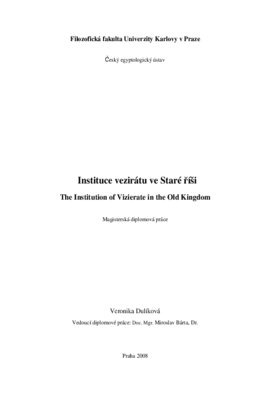Instituce vezirátu ve Staré říši
Institution of vezierate in the Old kingdom
diploma thesis (DEFENDED)

View/
Permanent link
http://hdl.handle.net/20.500.11956/14972Identifiers
Study Information System: 27537
CU Caralogue: 990011121620106986
Collections
- Kvalifikační práce [24310]
Author
Advisor
Referee
Vachala, Břetislav
Faculty / Institute
Faculty of Arts
Discipline
Islamic History and Culture - Egyptology
Department
Czech Institute of Egyptology
Date of defense
30. 5. 2008
Publisher
Univerzita Karlova, Filozofická fakultaLanguage
Czech
Grade
Excellent
Predkládaná práce se zabývá institucí vezirátu ve Staré ríši, reší otázky podoby a interpretace vezírského titulu, titulatury, kariéry a prostorové distribuce hrobek vezíru. V období Staré ríše nesli vezíri kompozitní titul 5, tAyty TAty (n) zAb, jehož doslovný preklad pravdepodobne je "TAty krále v podobe šakala, jenž náleží predsíní paláce". V souladu se staroegyptskými predstavami byl úrad vezíra zpocátku spojen se synem krále. Na prelomu 4. a 5. dynastie vlivem spolecenských zmen nastala zmena, clenové královské rodiny byli vylouceni z úcasti na správe státu a nejvyšší správní úrad byl obsazován osobami nekrálovského puvodu.
This diploma thesis deals with the institution of vizierate in the Old Kingdom and solves the questions connected with the form and the interpretation of vizier's title, the titulary, the career and the spatial distribution of vizier's tombs. In the Old Kingdom viziers bore the composite title 5, tAyty TAty (n) zAb, with a presumable literal rendering "the TAty of king in the appearance of jackal, who belongs to the hallway of Palace". In correspondence with the Ancient Egyptian conception, the office of vizier was initially associated with the king's son. The end of the fourth and the early fifth dynasty represented a turning point influenced by social changes. During this period the members of royal family were excluded from the participation in the state administration and the highest administrative office was entrusted to officials of non-royal origin.
